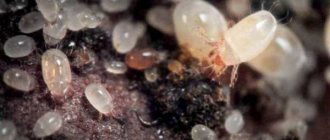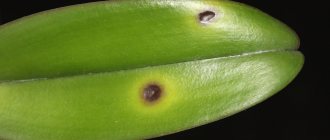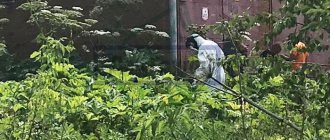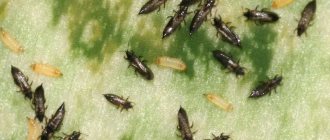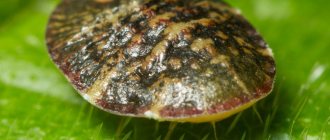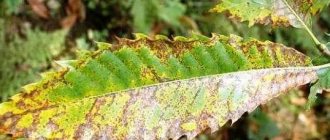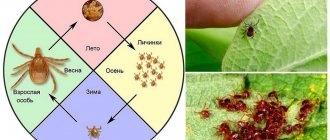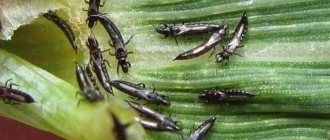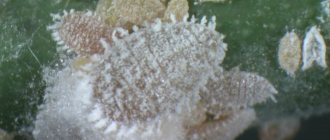Despite the fact that the number of root mites is much smaller than that of spider mites, aphids, and scale insects, they cause serious damage to plants. These pests are very smart and cunning. Carefully hiding in the ground and hiding their lair, they eat plant roots. Soil mites pose a danger to indoor and bulbous plants. Most of all they love to feast on orchids, lilies, daffodils, hyacinths and tulips. The parasites begin to gnaw the bulb from below. Climbing between the scales, they infect the diseased tissues of the bulbs, and then proceed to the healthy ones. The plant stops blooming and bearing fruit and dries out. When a bulb is damaged by a soil mite, it becomes covered with brown dust.
A root mite is a small spider. It has three pairs of legs, sharp antennae, and a large light transparent oval body. The parasite is very hardy. Can live for a long time without moisture and food. It feeds on underground parts of plants and organic remains. Lives in tops and fallen leaves.
Description of the pest
Onion root mite is one of the main types of parasites that damage the underground parts of the plant. It is easy to recognize by its appearance: it is translucent, with a shiny surface, milky or yellowish in color.
He is very hardy, and without food and moisture he does not die, his life processes just slow down. But when the temperature rises to +20 °C and the humidity rises, they come to life again and begin to actively feed on roots and bulbs.
Root mites have strong jaws, so they very easily and quickly eat bulb tissue , where in the freed space, females lay large clutches of eggs. Gloxinia, hyacinths and orchids are more susceptible to infection than others.
The role of soil mites in nature
Soil is a complex of living and nonliving components that are present in various combinations. Small arthropods, including several groups of mites, contribute to the solidification of the humus fraction and also allow the existence of soil organisms.
Even though mites play a role in soil mixing, it may be small compared to larger invertebrates such as earthworms, insects, crustaceans and centipedes. But at the same time, mites perform an important function in mineral turnover, which allows vegetation to grow, and also participate as destroyers of organic matter.
Soil mites organize a density of 50,000-250,000 units per square meter, which can be found in the upper layers of the soil. Dozens of species can be found in a small area when the soil is rich in organic material such as decaying vegetation, excrement or animal remains. In combination with the microflora on which ticks feed, many of their species help in the decomposition of organic matter that they are able to digest. Thus, soil mites play, if not the main, then an irreplaceable role in the formation of an ecosystem of fertile humus.
According to the nature of their feeding, ticks are divided
Pests are divided into several groups. This is facilitated by differences in eating habits. Microscopic mites do not have a powerful mouthparts. For this reason, representatives of some species first spread the infection and then begin to feed on the tissues of weakened plantings. The feeding process of predators follows a similar principle.
But the pincers
They introduce special substances along with saliva that liquefy the tissues of insects and other arthropods.
Saprophages
This is the name given to individuals that receive the necessary nutrients after the death of a plant or living organism. They don't harm people. On the contrary, such individuals contribute to soil mineralization.
Root mite inhabits
of this species in the ground, eggs and larvae appear here.
Phytophagous
The source of food for such individuals is plants at different stages of development. Pests destroy above-ground and underground parts of plantings. This group includes a large number of varieties. Another name for such individuals is herbivores. The danger of phytophagous pests lies in their small size. This prevents them from being detected in a timely manner. The principle of eating is based on the ability of mites to pierce the outer shell of plants, then with the help of a proboscis they suck out the juice, which leads to the weakening of flowers and crops and their death.
Predators
Ticks of this group consume mainly other individuals: insects, invertebrates, nematodes, and even representatives of other types of arachnids. They rarely cause harm to people, as they differ in feeding habits from blood-sucking individuals.
On the contrary, they are beneficial
– contribute to the natural control of the number of colonies of parasitic individuals.
Family of soil mites
Signs of infection
Root mites harm a variety of plants, primarily by damaging their underground organs. Most often they settle on garlic and onions. Among ornamental plants, they most often infect daffodils, tulips, orchids, gladioli, dahlias and hyacinths. But root mites in indoor flowers are still relatively rare. Plants are harmed not only by adult mites, but also by their larvae.
The leaves undergo deformation - they may warp, and areas different from the main color of the leaves begin to appear on them. The plant stops growing, its peduncle primordia are deformed.
Important! Diseases caused by root mites may be caused by pots in which the soil has not been changed for a long time or the drainage does not function properly.
Damaged bulbs begin to mold and rot. If the bulb has been affected by root mites for a long time, it begins to shrink and loses its elasticity due to dehydration. In the later stages of the lesion, the bulb crumbles into brown dust, and the bottom falls off. Larval skins and excrement of mites can be found in the dust; mites themselves are often found at all stages of development.
Ways to get into a flower pot
To detect soil mites, you need to remove the indoor plant from the pot; in open ground, dig a small hole near the root system and inspect the contents of the soil.
Reasons for the active reproduction of soil mites in indoor flowers:
- frequent and abundant watering;
- lack of drainage and removal of excess liquid in flower containers;
- improper placement of crops (near heating devices);
- old stagnant substrate;
- planting weakened, damaged bulbs, infected seeds;
- highly compacted multicomponent soil mixture that does not allow air to pass through;
- improper storage of planting material.
How to deal with soil mites?
If the substrate is heavily infested with mites, it should be immediately replaced with a fresh one, and the roots of the plant should be thoroughly disinfected. Tansy decoction is ideal for this , which is very easy and simple to prepare. Take 100 g of dry herb and brew it for about 15 minutes in 1 liter of boiling water. Allow the broth to cool and dip the roots or bulbs into it for 30 minutes.
To limit the number of ticks, you need to regulate the moisture in the soil. To do this, you need to stop watering for 7-10 days, and create a good drainage layer at the bottom of the pot, which will regulate the amount of moisture received by the roots.
If a soil plant is seriously infested with mites, one should resort to more serious methods of control, such as chemicals:
- Akarin. A biological agent that has an intestinal contact effect.
- Apollo. A concentrated suspension that has a contact effect on parasites. The rate of its use is always the same - take 2 ml. for 5 l. water.
- Vertimek. A natural preparation created on the basis of a mushroom.
- Mites. An insectoacaricidal drug that is best suited for protecting ornamental plants in closed ground. The effect of this remedy is observed already on the 3rd day after treating the diseased flower.
- Envidor. The drug adheres to the leaves of the diseased plant and prevents further reproduction of pests. Already on the 15th day the flower can be completely healthy.
- Nissan. Effectively kills males, but does not have a detrimental effect on females. In this case, the vital activity of the eggs stops, due to this, the mites die out after a few days.
- Nurrell-D. Copes with all types of ticks at various larval stages. Also fights adult parasites.
- Sunmite. The active effect of the drug will allow you to neutralize the plant after 15 minutes of use. Plants should be sprayed with a diluted solution, and the soil should be sprinkled with powder.
- Flumite. It has a sterilizing effect, due to which females lay non-viable eggs.
- Omite 30 and Omite 57. Effectively destroy most phytophagous mites. They affect the active stages of arachnid development through direct contact or in pairs during evaporation. They do not affect the eggs, but the residual effect of the drug kills the larvae.
- Borneo. They destroy the eggs and larvae of arthropods, do not kill adults, but sterilize the females, thereby reducing the pest population.
In the fight against soil mites, it is quite effective to use traditional methods:
- Soaking the roots of a diseased plant in tansy tincture. The herb can be used both fresh and dried. If freshly picked tansy is used, then you need to take 150 g, if dry, then 25 g. The raw materials are poured into 0.5 liters. hot water and leave for about 20 minutes, then dilute with clean water in a 1:1 ratio. For best results, cleaned tubers and plant roots should be kept in this solution for about 15 - 30 minutes.
- As a spray, you can use a tincture based on wood ash. To do this, infuse 1 tbsp for about a day. ash in 5 l. water. It is also good to add 50 g of crushed laundry soap to this mixture.
- Infusion of alder leaves. In 1 l. boiling water for 36 hours, infuse a tablespoon of finely chopped herbs. The roots of the plant are kept in the infusion at 45 degrees. Do not leave naked bulbs in this healing mixture for more than 8 minutes.
- Spraying with garlic infusion. 2 medium heads of garlic should be placed in a container with 1 liter. boiling water Close tightly and leave for about 5 days in a dark place. Before spraying, dilute the solution 1:1 with clean running water.
Preventive measures against infection
Reference! To avoid infestation of potted plants with root or soil mites, they should be provided with good drainage. Do not over-water flowers, especially in humid indoor climates. You should try to keep the pallets dry; stagnation of water in them is completely eliminated.
Planting material should be stored properly to avoid the appearance of parasites in it. To do this, select sealed packages and place them in a dark and comfortable room in terms of humidity. For planting, you should choose shaded places and control the level of humidity in the room and in the soil.
When root mites appear in indoor plants, immediate measures should be taken to destroy them. The faster preventative work is carried out, the less chance neighboring indoor flowers will have of becoming infected. To prevent soil contamination, you need to control the soil moisture and monitor the drainage of the pot component.
Chemical and biological preparations for plant treatment
Methods to combat spider mites include the use of improvised means and specially developed preparations. The first option is environmentally friendly, but in case of severe infection it is not effective. At the first sign of a pest, it is recommended to treat all plants with a soap solution (100 g of laundry soap per 10 liters of water). Infusions of onion peels, garlic and tobacco are used.
Eco-friendly and safe methods of destroying phytophages include the use of the predatory phytosailus mite. It is enough to place 60 individuals per m2 of land to get rid of eggs, larvae and adult pests. Acarifage is active at temperatures above 20 and high humidity. After removing all enemies, the predator will die without food.
Chemicals are much more effective in the fight to preserve the crop. Many means have been created that can destroy the pest at various stages of development.
- Karbofos is an organophosphate substance, insecticide and acaricide. Available in various forms and concentrations. The active ingredient malathion is effective against insects and arachnids. The duration of protection in open ground is 10 days, in a greenhouse – up to 7 days. Spraying is carried out in the evening in calm weather.
- Actellik is a spider mite remedy suitable for use on open and protected soil. The drug is an insectoacaricide; it does not affect the plant, it only poisons pests. The enteric-contact substance has fumigant properties, destroying phytophages on both sides of the leaves. Duration of exposure is 2-3 weeks.
- Apollo - the action of the acaricide is aimed at eggs and larvae. This drug is one of the few that can cope with pests at an early stage of development. The active compound clofentesine sterilizes adults, preventing reproduction. Apollo is a contact acaricide; to poison eggs, it is necessary to thoroughly moisten the plants with a freshly prepared solution. The substance is slightly toxic, safe for people and insects. The drug protection lasts up to 2 months.
Causes of infection
Ticks live well in warm and moist (even completely liquefied) substrate. Therefore, constant excessive waterlogging of the soil can cause their appearance.
They are also easily transmitted from one infected plant to another. Therefore, infected plants are destroyed or isolated from healthy ones, or immediately treated, while simultaneously carrying out prophylaxis among healthy plants.
The easiest way to infect plants with mites is to purchase bulbs or substrate from the store that already contain the parasite.
In case of severe damage
How to deal with soil mites if the number of affected areas is already large? Folk remedies can no longer cope; more intensive measures must be used. Treatment with systemic insecticides will help destroy all parasites. Moreover, this remedy acts for a long time, so it manages to destroy even the future generation. Actellik or Neoron are best suited. Do not forget that insects get used to the drugs used, and therefore they should be alternated. Typically, systemic insecticides can save the plant even in the most advanced cases. And only if the bulb begins to rot due to a large amount of damage, it becomes impossible to save it.
Preventing the appearance of parasites in the apartment
Following preventive measures will help save plants and prevent pests:
- regularly check flowers for damage and parasites;
- keep new plants in quarantine for 2 weeks;
- install mosquito nets on the windows;
- do not allow the flower to dry out, spray it regularly, since mites cannot tolerate high humidity;
- remove fallen leaves and buds in a timely manner;
- carry out preventive treatment with protective drugs, wipe the leaves;
- disinfect the soil before transplanting flowers (freeze or evaporate).
Spider mites are a dangerous pest that in a short time can form a large colony of parasites that destroy house plants. Insecticides and folk remedies will help preserve the beauty on the windowsill. To prevent the problem from recurring, follow preventive measures, create unfavorable conditions for insects and provide proper care for the flowers.
Pest prevention
To prevent the appearance of mites, it is necessary to properly handle the bulbs and planting material.
- Do not buy seed, seedlings and flowers if they make you suspicious. Mites most often hide under the first two sheets of onion scales; they are easy to see if you move the scales apart a little. If you cannot check the bulb for mites, it is better to refuse the purchase.
- Own plant material is dried before planting. Onion sets are kept at a temperature of +40°C for 16 hours, after which they are planted in the soil. Seed material for indoor plants is treated with acaricides.
- It is recommended to water the planted plants from time to time with water at a temperature of about +35°C. Such water will be fatal to parasites. During the period of active growth, plants can be sprayed with infusions of tomato tops or chamomile.
On a note! Biological methods are also used to destroy root pests. Hypoaspis mites will happily feed not only on root mites, but also on thrips, regulating the pest population.
Before storing, you need to thoroughly dry both the storage and the bulbs. It is recommended to etch the storage facility with sulfur dioxide. The bulbs are treated with agents against fungi and mites.
Temperature and humidity in storage facilities are reduced. The plant material is powdered with chalk and colloidal sulfur. It is necessary to regularly inspect storage facilities in order to promptly find moldy areas and remove them.
Control measures
Mite-affected onion
Prevention
Correct crop rotation
The location of onion beds must be constantly changed. Attention to planting material. No damaged bulbs should be present in the seed material. When harvesting, all rotten root crops are also immediately removed, since it is in them that pests settle. Before storing, the warehouse must be thoroughly disinfected, ventilated, and dried.
A low-humidity regime must be created in it. To disinfect storage facilities, a fumigation procedure with sulfur dioxide is used. In this case, 100 g of sulfur is burned per 1 m3. This procedure is carried out long before the new harvest is received. Before this, all accumulated garbage is burned. Bulbs can also be fumigated. When growing onions commercially, storing them involves sprinkling them with vivianite or dry chalk. For 1 ton of harvest, about 20 kg of these components will be required. The disinfecting factor for onions is drying at a temperature of + 35 C for a week. At the same time, if we are talking about small seedlings, then it is necessary to control the situation to ensure that the material dries out, which will lead to loss of germination.
Chemicals
Fighting ticks is a long and difficult process. If it has already settled on the site, then it can really be eradicated by using toxic chemicals. These are funds of two categories:
- acaricides;
- insectoacaricides.
Before resorting to chemicals, you must carefully study the information indicated on the packaging of the product or in the annotation attached to it. The use of aggressive chemicals must be thoughtful so that the toxic components do not harm the health of people who will eat onions. First of all, it is worth studying the etching time limits and dosage.
DI-68 is a modern effective drug against ticks
When choosing drugs against onion root mites, you should consider the following:
- Bi-58 New;
- Dimethoate-400;
- DI-68;
- Nugor;
- Fostran;
- ProRogor;
- Ditox;
- Kinfos;
- Danadim;
- Kemidim;
- Binomial;
- Rogor S;
- Tagore.
How to get rid of pests
If the lesion is minor, and you noticed it on time, then no problems with treatment should arise, especially if you know how to get rid of soil mites.
- The easiest way is a soap solution. They water the ground with it and wipe the leaves.
- The second most popular, but not most effective, is an infusion of garlic in water. Usually the procedures are repeated until all symptoms of the disease disappear completely.
- For indoor plants, you can use an ultraviolet lamp. It is enough to keep it on for two minutes a couple of times a week, and all pests will completely disappear.
- Nettle also helps fight pests. To do this, take 0.7 kg of nettle and pour 5 liters of boiling water. Place the vessel in a warm place. After five days, strain, dilute 1:10 and water at the root.
Folk remedies
Folk remedies are very popular and in demand, since they are absolutely safe, but at the same time they help effectively fight pests:
Tansy. To do this, you need to prepare an infusion of fresh or dry tansy. If you have fresh herb, you will need 150 g of herb and 0.5 liters of water, use only boiling water, leave for 20 minutes. When using dry herb, you will need 25 g, add the same amount of water and leave for the same time. Next, the infusion must be diluted with water, maintaining a 1:1 ratio. Used as an effective means to get rid of pests when transplanting flowers. Dip the roots and bulbs into the infusion for at least half an hour.
Wood ash. It is used as a tincture for treating the plant itself, as well as for the top layer of soil. For cooking you will need 1 tbsp. l. pour 5 liters of raw materials. water, leave for 24 hours. Before use, add laundry soap to the infusion, you will need 50 g, it is better to grind it so that it dissolves well.
Alder. To prepare the infusion you will need crushed leaves. You need to take 1 cl. l. crushed leaves and pour 1 liter of boiling water, leave for 1.5 days. The infusion is used before planting flowers; it must be heated to 45°C and the roots should be dipped into it and left for about 8 minutes.
Garlic. This infusion helps repel pests, both soil mites and other insects. The action is carried out thanks to the smell. To prepare, you need to take 2 heads of garlic, peel and chop, then place in a container that is hermetically sealed. Pour 1 liter of water into it and close it, you need to leave it for 5 days, but you need to place the container in a dark place. Before spraying plants, dilute in a 1:1 ratio with water.
These traditional methods not only help get rid of pests, but also have a beneficial effect on the plant itself. Their use helps strengthen the flower, make it more resistant to various types of pathogens that cause diseases and create unfavorable conditions specifically for pests.
Structure and shape
Representatives of soil mites - putrefactive and bulbous mites - that are similar in morphological characteristics can be examined in more detail using the example of the second. Its influence on the fruits of human labor in the field of agriculture and gardening obliges us to know the enemy by sight.
Both of these species are polyphagous, that is, they are not particularly picky about food; in other words, they eat everything, from the rough roots of cereals to the delicate bulbs of chrysanthemums. They also do not disdain the root crops of onions, carrots, beets and potatoes, which is why they have earned a sad reputation among gardeners.
In addition to their natural home - earthen soil, these creatures also spread into vegetable stores, cellars and barns.
The means of delivery there are the same plants and fruits that they ate in the wild, and now they will continue to eat them in storage areas, significantly reducing the shelf life of vegetables and cereals.
In their structure, these creatures are similar to the entire family of acarids:
- An adult individual, imago, has an oval, wide and tapering body of a light yellow color, covered with a soft chitinous shield at the base. Short, thick limbs are armed with spines and covered, like the whole body, with bristles.
- Females are 2–3 tenths of a millimeter longer than males and reach just over 1 mm.
- The nymph is the next phase of the development of the soil mite after the larva, exceeding that in size, but inferior to the imago, also having four pairs of legs.
- Larvae are embryos hatched from eggs with three more pairs of legs.
- The egg of the bulb mite is usually white, has a characteristic shape and is relatively large in size.
Another, separate, phase of the nymph, during which the creature experiences unfavorable climatic and other conditions for further development, is called hypopus. At this stage, all vital processes slow down as much as possible, which helps to tolerate temperature and humidity parameters that are critical for the normal state of the individual.
Interesting to know
“The change of phases occurs through the so-called molting, when the old chitinous shell is shed, which indicates favorable growth conditions”
Chemical attack on root mite
Root mites are resistant to pesticides. For preventative purposes, before planting a home plant, its tubers (or bulbs) are dipped in an oil-soap solution: dissolve half a tablespoon of washing powder in hot water (200 ml). Add 0.5 tbsp to the soap solution. oil (machine). Bring the emulsion to 1 liter with water. The roots should remain in the resulting warm mixture for about half an hour.
Neoron is a time-tested chemical, but ticks can get used to it
Neoron, Apollo, Actellik... These insecticides will be effective if you alternate their use with each other. At the same time, it is better to spray Actellik on those flowers that are located in non-residential premises. Acaricides are also effective: Clofentezin, Karbofos, Dimethoate-400, etc. Pesticides such as DI-68, Tagore, Danadim, ProRogor, Fostran and others are also used. During the period of vegetative growth of domestic plants, if a root mite is detected, the fight should be carried out with a 0.2% solution of Rogor or Keltan. If damage is detected on the roots or bulbs, they must be kept in a solution of Acaricil or watered on the plant. You can also disinfect it in one of the solutions of systemic insecticides Neoron, Apollo.
Nothing brings joy on winter days like a homemade flower in the window. To protect it from pests, you need to know how to combat pathogens and successfully apply knowledge in practice.
Check out articles on similar topics
- Thrips on indoor plants: methods of control and treatment
- How to get rid of whitefly pest on indoor plants and flowers
- How to deal with mealybugs on indoor plants
- How to get rid of scale insects and remedies on indoor plants
Comments
- Svetlana
A cry for help. I bought several hippeastrum bulbs of different varieties and from different sites and didn’t look much further. All but one have successfully bloomed and are growing, and one seemed to have a missing growth point and did not wake up for a long time. So that it wouldn’t all be in vain, I tried to get children from her, but now I’m crying and don’t know what to do. The onion mite has colonized all the pots and even the crops with children, basically everywhere, and I have about a hundred plants and half of them are bulbous. Help, please, tell me what to do. Fitoverm, Actellik and others like that do not help. I also can’t dry out plants. The land has already been changed more than once. Even before throwing away, I heat everything contaminated at a temperature of 200-250 degrees. I also heat up the new purchased soil and wash the bulbs, but nothing helps.21.06.2018
Answer
leave a comment
Why is it dangerous for plants?
Since this insect sucks the juice from the leaves, this leads to the gradual death of some tissue. Numerous “dead zones” form a drying area, resulting in leaves falling off. And without foliage, the plant cannot feed and develop, so it dies.
In addition to this main reason why ticks are dangerous, there are several more:
- it carries viral and fungal diseases;
- spreads gray mold spores;
- makes the plant vulnerable to disease.
Before the insects have time to multiply exponentially, it is immediately necessary to apply various methods of combating larvae, eggs and adults of spider mites.
Characteristic
Strawberry transparent mite belongs to the family of mites. It has a flattened translucent body with rather hard integument. The size of females is about 230 microns, males - 145 microns. In this case, the width of the body is approximately two times less than the length. The size of these creatures is so small that it is impossible to see them with the naked eye.
On a note! Because of these features, the strawberry mite can only be seen when its photo is enlarged many times over!
The strawberry mite is distributed throughout Europe and North America; it lives where strawberries and wild strawberries are cultivated. As a result of its vital activity, this creature causes enormous damage to the harvest of these plantings, not only for the current year, but also for the future. This happens because the parasite disrupts the normal development of plants and adversely affects the formation of flower buds in the month of August. Its harmfulness often depends on the age of strawberry plantings and reaches its maximum value in the third or fourth year of their development.
Infection of beds in most cases occurs when using planting material on which the strawberry mite has already settled. And it spreads throughout the garden during weeding and other plant care activities. The parasite moves to neighboring bushes through tools, clothing and shoes when leaves or tendrils come into contact with them.
Warm, humid weather is favorable for the reproduction of strawberry mites, when the thermometer reaches +20. 25°C, and humidity fluctuates between 80 and 90%. At the same time, direct sunlight is destructive for parasites - being under their direct influence, the pest’s body becomes dehydrated and soon it dies. For this reason, the mite always settles on the underside of the leaf blade or on the lower part of the stem - close to the ground.
Tyrophagus
This species is no less dangerous and can cause significant damage. They live in the ground, but if the humidity is too high, they move to more comfortable conditions, namely the leaf part. Most often they take in young shoots. Signs by which infection can be determined include the bulb drying out, spots appearing on it, punctures appear on the leaves, and a brown coating forms on the bottom of the leaves.
They are combated by regulating the level of humidity using specialized means. In order to get rid of pests on the plant itself, it is treated with Fitoverm. To destroy it in the soil, it is sprinkled with a special powder, for example, Nissoran is used. It is very important to comply with the storage standards for planting material. Before sending it for storage, it must be warmed up and stored only in a dry place. If any damage is found, the material is removed.
How to recognize a spider mite
The first signs of mite infestation of plants:
- The leaves begin to turn yellow from the bottom. Affected areas lose chlorophyll, become discolored and dry out.
- Since the leaves do not receive the required amount of nutrients, they curl and fall off.
- The places where the spider mite colony has settled are covered with a thin web.
- If you do not start fighting these pests, the plant gradually weakens and may die.
Insecticides and acaricides for pest control
But if you don’t want to take risks, the defeat is quite serious, then only two options will be effective. Bulb mites and root mites will die from:
- Biological products against insect pests. Many modern preparations based on essential oils and extracts from plants, vermicompost, etc. have a systemic insecticidal effect. And they can be successfully used to combat root mites.
- Insecticidal preparations are an effective, but not the most effective method of control. Instead of systemic insecticides, it is better to use more “highly specialized” drugs - acaricides, designed to combat ticks specifically.
Treatment with both biological and chemical insecticidal agents is carried out in the same way: the bulbs are soaked in the solution, strictly following the manufacturer’s instructions for its concentration and duration of treatment. After disinfection, the bulbs are thoroughly dried, and only then they begin to plant.
Any container (even a new one) in which an onion that has been treated against root mites will be planted will have to be disinfected. For cleaning, use either alcohol, boiling and scalding, or a solution of insecticides.
Only fresh soil is used for planting, preferably from ready-made purchased substrates with a guarantee of treatment against soil pests.
Life cycle
Females are distinguished by significant fertility: one female lays up to 800 eggs. But unfertilized females do not lay eggs. From 5 to 25 pieces are deposited per day. The female lives up to two months.
Each generation develops within 10-30 days.
Females lay eggs in bulbs or in the substrate on which they have settled.
Eggs. The embryo develops from 4 to 11 days, depending on temperature.
Larva. Development occurs at temperatures from +15°C to +25°C and air humidity of 80-100%. Development, depending on conditions, lasts from 2 to 22 days. When humidity is below 60%, the development of the larvae stops.
Hypopus. Under unfavorable conditions or lack of food, a very resistant form of the pest (hypopus) appears. In this form, ticks can exist for a very long time in the absence of food. Hypopus can be spread by the onion fly, hoverfly, onion secrecy and other insects.
The lower threshold for the development of the pest is + 9.7 ° C. The sum of effective temperatures required for the full development of one generation is 181 °. All stages of the pest are observed simultaneously.
Rhizoglyphus
This tick is distributed throughout the world, its diet consists of different types of food. It can feed on grape roots, onions, potatoes, cereals and ornamental flowers. The size of the pest reaches 0.8-1 mm, the body is elongated, light in color with a yellow tint. The paws are well developed, with spines on each limb.
If the bulb has damage, then the mite penetrates into the middle through them; there is no accessible road, then it gnaws through it. In the middle of the bulb it absorbs the juice, which causes harm. In areas where the climate is warm and important, flowers planted in open ground are at risk. Daffodils, gladioli, tulips, etc. are under threat. Infected flowers cannot develop normally and their growth slows down; in addition, they are susceptible to infection with various diseases.
If these mites get on human skin, irritation and severe itching will begin. They love moisture very much, and at elevated temperatures, life processes and development accelerate. The female lays up to 800 eggs, from which larvae appear within a week. The life cycle of an adult is 2 months.
Kinds
Four-legged garlic mite (Aceria tulipae)
Exceptionally small even among ticks. The length of an adult female is 0.25 mm, width – 0.15 mm. Males are even smaller - 0.21 x 0.10 mm. It parasitizes the bulbs of many plants of the lily family, but is most often found on garlic, onions and tulips, both on vegetative plants and on planting material. At temperatures above + 9 °C they become active. At +18…+20 °C a new generation appears every 8–10 days. Females crawl onto the surface of the leaves of affected plants, from where they are carried by the wind. These pests can use various insects as unique vehicles. The second period of active spread is the storage time of the collected bulbs. If there is high humidity in the storage, mites crawl from the affected bulbs to healthy ones.
Signs of defeat and damage. Leaves become deformed and light spots may appear. At the moment of resettlement of females, the plant becomes covered with a whitish coating (the bodies of mites). Affected bulbs have characteristic yellow spots on the fleshy living scales. Over time, the bulb becomes dehydrated and shrivels. Often, rot and mold begin to develop on damaged tissues, which later spread to the entire bulb. Four-legged mites not only depress plants, but also spread infections.
Loading…
Onion root mite (Rhizoglyphus echinopus) and related species
Translucent, often slightly yellowish or whitish in color. When observed through a microscope, the long bristles on the body immediately catch the eye. The size of adult females can reach 1.1 mm. They live in the soil for a long time, feeding on fungal mycelium and plant debris. When a female mite enters a plant, it burrows into a stem, tuber or bulb, where it lays eggs. During her life (30–40 days), the female can lay from 100 to 800 eggs. A colony quickly appears in the affected plant. Activity begins already at +6 °C. At +20 °C, a new generation of the pest appears every 20 days. At +25 °C, it takes only 10 days for a new generation to appear. Temperatures above +35 °C are detrimental for many ticks of this genus - they fall into torpor. With a further increase in temperature, they die. When a colony is threatened with starvation, special larvae appear - hypopus. They do not feed and are very resistant to atmospheric drought and to the effects of not only chemicals, but also radiation. Their only task is to find new places to eat. The hypopus has special hooks on its legs, with the help of which it is fixed on the body of insects and on the fur of animals.
Signs of defeat and damage. The affected scales of bulbs and tubers gradually wrinkle and dry out, turning into dust. Various fungi begin to develop on the affected tissues, causing rot and mold. Plants from affected bulbs are weakened. The seedlings do not develop, get sick and very often die. These mites cause severe allergies and asthmatic complications in vegetable store workers and bulb sorters. There is even a special medical term - rhizoglyfusiosis (a disease caused by ticks of the genus Rhizoglyphus).
Putrefactive elongated mite (Tyroglyphus putrescentiae)
If root mites purposefully search for and infect bulbs and tubers, then putrefactive mites begin to cause harm only under certain circumstances - high humidity and elevated temperature in the storage. Externally they are very similar to root mites. Only putrefactive mites have longer and thinner hairs. Almost omnivorous, they destroy plantations of champignons and oyster mushrooms, damage leaves on seedlings of asters and cucumbers, and render cheese starter unusable in cheese factories. If tubers, bulbs, and root vegetables are stored at high humidity, they will inevitably be damaged by putrefactive mites.
Signs of defeat and damage. Rot mites always have spores and particles of fungal mycelium on their bodies, so they also infect stored plant material. While feeding, the mite causes damage to plants (roots, bulbs, tubers), and fungi and bacteria immediately settle on the injured tissues - the bulbs become covered with rot and mold. Mites of this group cause allergic diseases in people whose professions are related to the storage and processing of grain, groceries, cheese making, storing vegetables, and sorting bulbs. Eating foods containing arthropods can cause indigestion and even foodborne tick-borne anaphylaxis.
Source
Acarid mites - pests on tubers and bulbs
Representatives of the family of acarid or grain mites can be found in various places - apartments, granaries, and on the human body. They are also present in the soil. Two types of arachnids live on the roots and tubers of plants:
- Tyrophagus - elongated mites;
- Rhizoglyphus - bulb mites.
Rhizoglyphus
The root bulb mite is widespread in all countries. It is a polyphagous organism that eats various types of food. The pest's diet includes onions, potatoes, grape roots, cereals and ornamental crops. The body is elongated, yellowish in color. The legs are short and thick, each with large spines. The length of an adult is 0.8-1 mm.
Through mechanical damage, the mite penetrates the bulb and feeds on its juice. If there are no holes, then it gnaws the road with strong claws. In regions with a warm, humid climate, decorative flowers in open ground and greenhouses are at risk. In damaged gladioli, tulips and daffodils, the growth process slows down. They can be infected with various diseases.
The pest is very moisture-loving; it thrives at 100% humidity. Its life processes accelerate with increasing temperature - at +150 the nymph develops in 22 days, and at +250 – 2 days. The female onion mite lays from 200 to 800 eggs. After 7-10 days, larvae emerge from them. The lifespan of adults is 2 months. But the pest also feeds in the early stages of development.
Tyrophagus
The elongated putrefactive mite causes no less damage than the onion mite. This pest under normal conditions lives deep in the ground. When humidity levels are high, it leaves the ground and moves onto the plant. The mite damages the leaf blade; it prefers to settle on young shoots.
Signs of soil mite damage include:
- the appearance of spots on the surface of the plant bulb;
- drying of the bulbs;
- the inside of the tubers turns to dust;
- the appearance of punctures on the leaves;
- a brown coating of scar tissue on the underside of the leaf blade.
The main measure to combat elongated and root mites is humidity control. To destroy the pest, plants are treated with Fitoverm. The soil is sprinkled with powders and granules - Sunmite, Nissoran. Bulb planting material should be stored in a dry place. They are warmed up before storing. Material with external damage is immediately removed.
